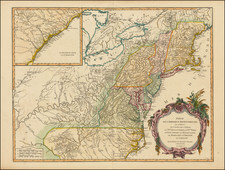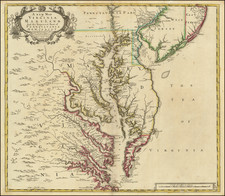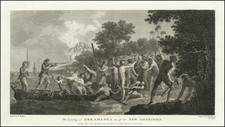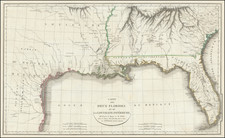Fascinating image of Native Americans conducting a meeting, from De Bry's Voyages.
At center, a Native American man presides over a meeting with his back to the viewer and his arms extended at his sides. A group of Native American men sit on a bench surrounding him while passing around a shell from which the men are drinking; two of the men are vomiting. In the right foreground, three women are boiling and mixing a liquid concoction.
Several Europeans with guns and spears talk amongst themselves in the left foreground.
De Bry's Engravings of the Florida Indians
For his Grands Voyages, De Bry engraved 42 plates based Le Moyne's original sketches made during the French Huguenot voyage to the Florida Peninsula. De Bry's renderings of Florida and its inhabitants are today the earliest known printed European images of Native Americans in present-day Florida, known as the Timucua Indians.
The images attempt to convey a number of messages about the land and its peoples. For example, some of the plates have been suggested to represent the ability of the Timucua to obey authority and that they are less sophisticated than the Europeans. This was argued to make them ideal candidates for French Huegonot colonization, to be used in conflicts against Catholic Spain.
The accuracy of De Bry's depictions have sometimes been called into question. Some of the engravings do not quite match what became known about the Timucua by later French explorers, and some engravings possess out-of-place features, such as the appearance of a Pacific nautilus rather than a Florida whelk shell. However, it is believed that the core of the imagery is correct. For example, the depiction of Timucuan body art, otherwise unknown to Europeans at the time, suggest that De Bry's depictions were grounded in reality.
Theodor de Bry (1528-1598) was a prominent Flemish engraver and publisher best known for his engravings of the New World. Born in Liege, de Bry hailed from the portion of Flanders then controlled by Spain. The de Brys were a family of jewelers and engravers, and young Theodor was trained in those artisanal trades.
As a Lutheran, however, his life and livelihood were threatened when the Spanish Inquisition cracked down on non-Catholics. De Bry was banished and his goods seized in 1570. He fled to Strasbourg, where he studied under the Huguenot engraver Etienne Delaune. He also traveled to Antwerp, London, and Frankfurt, where he settled with his family.
In 1590, de Bry began to publish his Les Grands Voyages, which would eventually stretch to thirty volumes released by de Bry and his two sons. The volumes contained not only important engraved images of the New World, the first many had seen of the geographic novelties, but also several important maps. He also published a collection focused on India Orientalis. Les Grands Voyages was published in German, Latin, French, and English, extending de Bry’s fame and his view of the New World.









![The North Coast of the Gulf of Mexico from St. Marks to Galveston . . . 1844 . . . Additions to 1856, including the Surveys of Comr. Powell, Lt. Simmes & Profr. Coffin, U.S. Navy [and] St. Marks to Galveston. Sheet II. . . . 1845. Additions to 1851 . . . .](https://storage.googleapis.com/raremaps/img/small/89497.jpg)

![[ Practices of the Outina Warriors ] Outinae milites ut caesis hostibus utantur. XV.](https://storage.googleapis.com/raremaps/img/small/97802.jpg)


